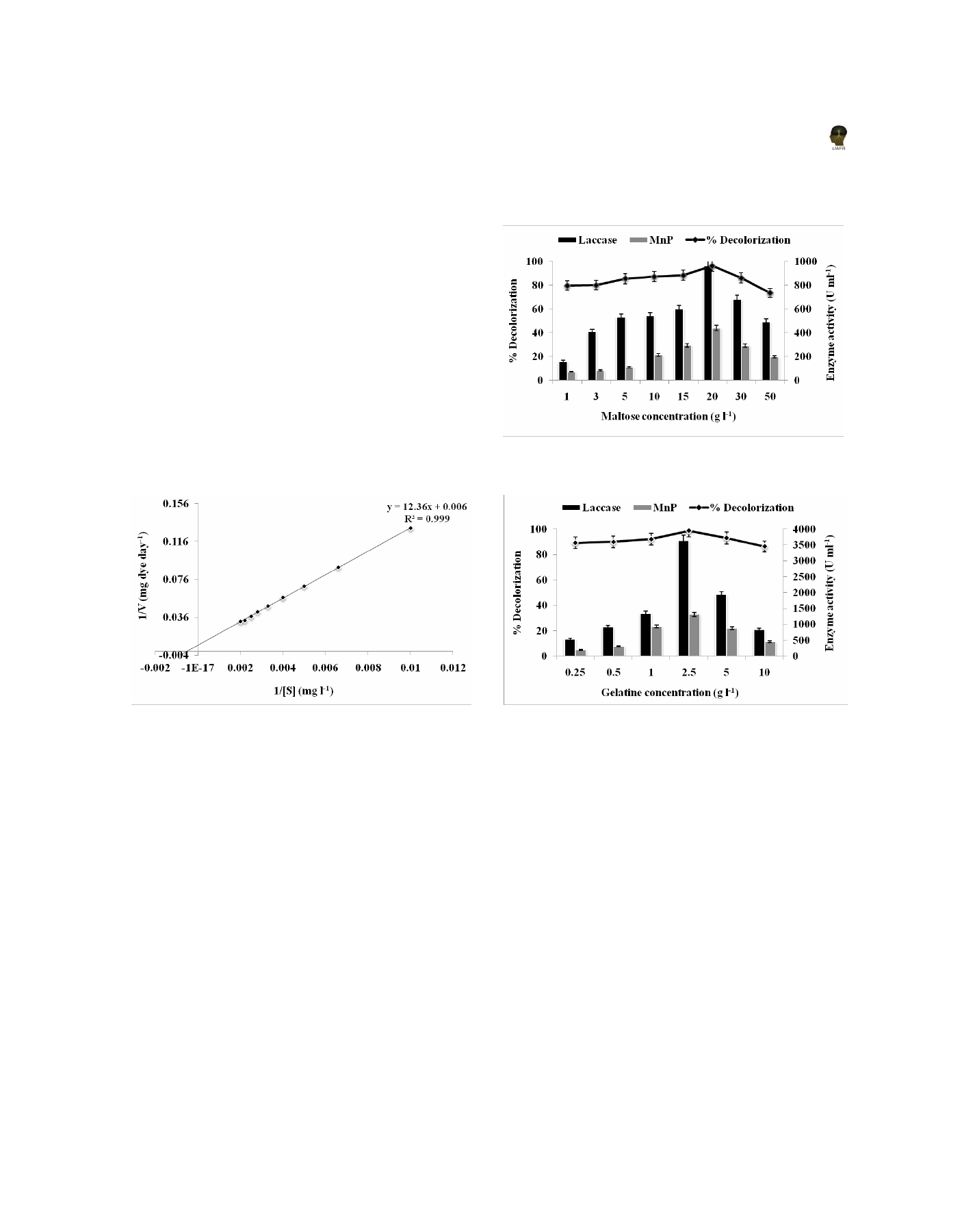
Molecular study of Pigeonpea
(572.34±24.6 U ml -1 ) and MnP (171±7.2 U ml -1 ) activities
enzyme activities may be owing to highly acidic condition
followed by glucose (91.35±3.5%). Sodium acetate was
or catabolic repression at higher maltose concentration.
found to be poor carbon sources allowing 64.32±3.3%
decolorization, whereas sucrose, lactose, starch, fructose
and xylose supported the decolorization in the range
between 74.32±5.4 and 89.55±2.8% by AGYP-1. Glucose
is known as the most readily usable carbon source for
most of the fungi. However, it is a costly carbon source
and is generally not used in wastewater treatment (Erdal
and Taskin, 2010). With this context, the preference of
maltose as a co-substrate by isolate AGYP-1 offers an
additional advantage for the removal of dye containing
wastewaters. Similar results were reported by Asgher et
al (2013), in which they obtained 91% decolorization of
Solar Brilliant Red 80 by Schizophyllum commune IBL-
Figure 7: Effect of maltose concentration on decolorization
06 in the presence of maltose.
of Reactive Red M5B by fungal isolate AGYP-1
Figure 6: Double reciprocal plot of Reactive Red M5B
Figure 8: Effect of gelatine concentration on decolorization
biodecolorization by fungal isolate AGYP-1
of Reactive Red M5B by fungal isolate AGYP-1
The concentration of maltose in the medium was
varied in the range of 1.0 to 50 g l -1 (w/v) for maximal
3.4.6 Effect of nitrogen source
removal of Reactive red M5B by isolate AGYP-1. The
The decolorization of Reactive Red M5B was performed
decolorization efficiency of the isolate AGYP-1 increased
in the presence of different organic and inorganic
with an increase in maltose concentration from 1.0 to 20
nitrogen sources; maximum decolorization of the dye
g l -1 ; with maximum color removal (96.33±1.2%) and
was obtained with gelatine (96.74±1.7%) after 10 days
laccase (963.38±28.34 U ml -1 ) and MnP (441.63±20.13
(Table 3). The growth of the isolate AGYP-1 was
U m -1 ) activities at 20 g l -1 (Fig. 7). The obtained fungal
0.297±0.02 g along with laccase and MnP activities
growth was 0.277±0.03 g at 20 g l -1 maltose concentration.
of 1537.1±14.6 and 791.64±12.5 U ml -1 respectively.
Any further increase in maltose concentration did not
Following gelatine, yeast extract and urea exhibited
influence an overall decolorization potential suggesting
93.73±4.4 and 92.41±3.5% decolorization of Reactive
20 g l -1 maltose concentration as an optimum for growth
Red M5B. The color removal efficiency of the isolate
and decolorization of the dye. The decolorization of the
was much lower in the presence of inorganic nitrogen
dye was 73.48±2.2% at 50 g l -1 concentration of maltose.
sources. Many researchers have reported enhanced
The reduced decolorization along with lower ligninolytic
decolorization activity of fungal cultures in the presence
507